If your garage door opener sensor is giving you problems, don’t panic! There are a few things you can do to try and fix it. In this blog post, we will discuss some of the most common causes of garage door opener sensor problems and how to fix garage door opener sensor. We will also provide some tips on preventing these problems from happening in the future. So, if your garage door opener sensor is not working properly, read on for some helpful advice.
Summary: Follow these steps to fix the garage door opener sensor: 1. Identify the problem. If the garage door opener sensor is not opening the door, it’s likely that the sensor is not working properly. 2. Check the wires. Make sure all of the wires are connected securely and are not crimped or pinched. 3. Check the sensor. If the sensor is not working, it may need to be replaced. 4. Test the sensor. After checking all of the wires and the sensor, try turning the garage door opener on and off to see if the sensor is working.
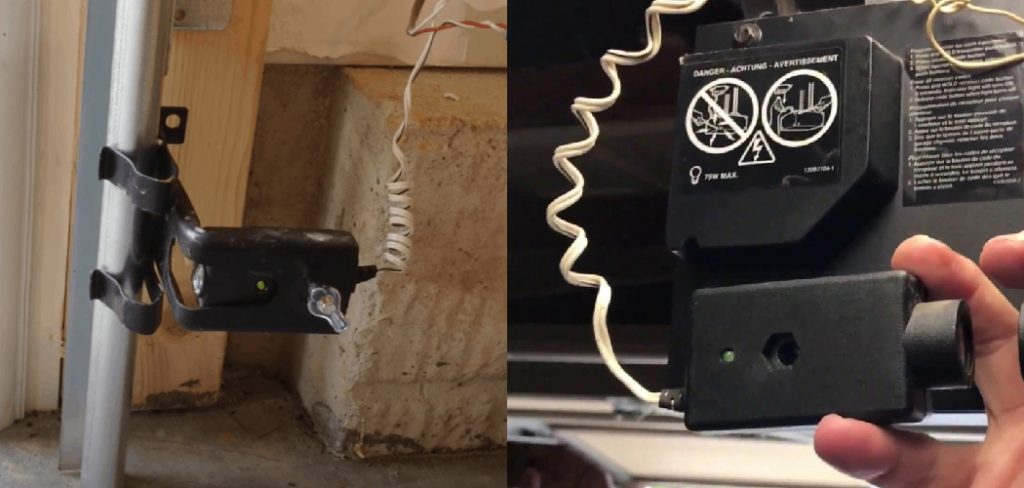
What Is Garage Door Opener Sensor?
The garage door opener sensor is a safety feature that is designed to prevent the garage door from closing if there is something in the way. The sensor consists of two parts: an emitter and a receiver. The emitter sends an infrared beam that bounces off objects in front of the garage door. If the beam is interrupted, it triggers the receiver, preventing the door from closing. Garage door opener sensors are required by law in many states and are a vital part of any garage door opener system.
What Causes Garage Door Opener Sensor Problems?
There are a few different things that can cause garage door opener sensor problems, including:
Dirt, Dust, and Debris
Over time, dirt, dust, and debris can build up on the sensor’s lens, causing the beam to be interrupted. This is one of the most common causes of garage door opener sensor problems.
Incorrect Sensitivity Setting
Another common cause of garage door opener sensor problems is an incorrect sensitivity setting. If the sensitivity is set too low, the sensor may not be able to detect objects in front of the door properly. Conversely, if the sensitivity is set too high, the sensor may falsely detect objects, preventing the door from closing even when there is nothing in the way.
Misaligned Sensors
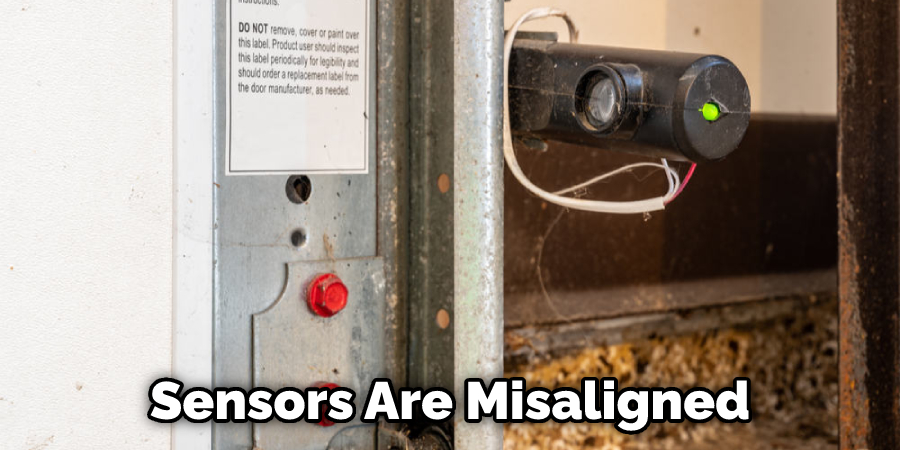
If the sensors are misaligned, it can cause the beam to be interrupted. Misaligned sensors are often the result of a collision with something, such as a car. The garage door can also cause misaligned sensors to be installed incorrectly.
Dead Batteries
Dead batteries are another common cause of garage door opener sensor problems. If the batteries in the sensor are dead, the beam will not be emitted, and the door will not close. Dead batteries can also cause the receiver not to work properly.
Wiring Problems
If the wires that connect the sensor to the opener are damaged, it can cause the sensor not to work properly. Wiring problems are often the result of an electrical surge or lightning strike. It is also important to make sure that the wires are not loose, as this can also cause problems.
Damaged Sensor
If the sensor itself is damaged, it will need to be replaced. This is usually the result of a collision or an electrical problem. A manufacturing defect can also cause damaged sensors.
Obstruction in the Path of the Sensor Beam
If there is an obstruction in the path of the sensor beam, it will cause the door to not close. This can be caused by anything that is blocking the sensor, such as a car, a toy, or even a leaf. Therefore, it is important to make sure that there is nothing in the way of the sensor before trying to close the door.
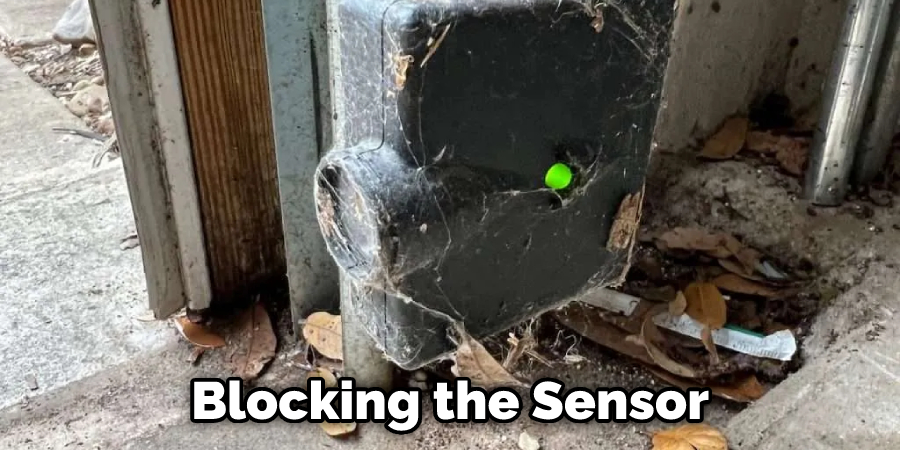
Step by Step How to Fix Garage Door Opener Sensor
Step 1: Ensure Safety Precautions
Before attempting to fix your garage door opener sensor, make sure that the area around the garage door is clear and free of any obstructions. Disconnect the garage door opener from the power source to prevent any accidental activation while you are working on the sensor.
Step 2: Identify the Problem
Begin by determining the nature of the issue with the garage door opener sensor. Common problems include the sensor being misaligned, obstructed, or dirty, or the sensor wires being damaged or disconnected. Observe the behavior of the garage door and the sensor lights to help identify the specific problem.
Step 3: Inspect the Sensor Alignment
Garage door opener sensors are typically installed on either side of the garage door, close to the ground. Check if the sensors are properly aligned by examining the sensor lights. If the sensors are correctly aligned, the lights should be solid. If they are blinking or not lit, it indicates a misalignment.
Step 4: Adjust the Sensors
To realign the sensors, loosen the screws or wingnuts holding the sensor brackets in place. Gently adjust the sensors until they are aligned and facing each other directly. Once the alignment is correct, the sensor lights should be solid. Tighten the screws or wingnuts to secure the sensors in place.
Step 5: Check for Obstructions
Inspect the area around the sensors for any objects or debris that could be blocking the sensor beam. Clear away any obstructions to ensure that the sensors can function properly.
Step 6: Clean the Sensor Lenses
Over time, dirt and dust can accumulate on the sensor lenses, which can interfere with their operation. Clean the lenses gently with a soft cloth or cotton swab, being careful not to scratch or damage them.
Step 7: Inspect the Sensor Wires
Examine the wires connecting the sensors to the garage door opener for any signs of damage, such as fraying or cuts. Also, ensure that the wires are securely connected to both the sensors and the opener. If you find any damaged wires, they will need to be replaced.
Step 8: Replace Damaged Wires
To replace damaged sensor wires, disconnect the old wires from the sensors and the opener. Purchase new wires compatible with your garage door opener model, and connect them following the manufacturer’s instructions.
Step 9: Test the Garage Door Opener
Once you have addressed any issues with the sensors, reconnect the garage door opener to the power source. Test the garage door opener by using the remote control or wall switch to open and close the door. Observe the sensor lights and door behavior to ensure that the problem has been resolved.
Step 10: Check for Electrical Issues
If the garage door opener sensor is still not functioning correctly after completing the previous steps, there may be an issue with the garage door opener itself or the electrical wiring. Test the garage door opener for any signs of malfunction, and inspect the electrical wiring for damage or loose connections.
Step 11: Replace the Garage Door Opener Sensor
If the issue persists after trying all the previous steps, it may be necessary to replace the garage door opener sensor. Purchase a new sensor compatible with your garage door opener model and follow the manufacturer’s instructions for installation.
Step 12: Test the New Sensor
After installing the new sensor, test the garage door opener again to ensure that the issue has been resolved. If the problem persists, it may be necessary to consult a professional garage door technician for further assistance.
Step 13: Perform Regular Maintenance
To prevent future issues with your garage door opener sensor, perform regular maintenance checks. This includes inspecting the sensors for proper alignment, cleaning the lenses, and checking the wiring for damage or loose connections. Address any issues promptly to keep your garage door opener functioning efficiently and safely.
Step 14: Ensure Proper Lubrication
Regularly lubricate the moving parts of your garage door system, such as the tracks, rollers, and hinges. Proper lubrication can help reduce friction, prolong the life of your garage door components, and prevent malfunctions that could impact the sensor’s operation.
Step 15: Inspect the Garage Door Hardware
Periodically inspect your garage door’s hardware, including the springs, cables, and brackets, for signs of wear, damage, or corrosion. Damaged or worn hardware can affect the overall operation of your garage door and, in turn, impact the functioning of the sensors.
Step 16: Keep the Garage Door Track Clear
Ensure that the garage door track is clean and free of debris that could obstruct the door’s movement or interfere with the sensors. Regularly clean the tracks and remove any debris to maintain smooth operation.
Step 17: Monitor the Garage Door Opener’s Performance
Keep an eye on the overall performance of your garage door opener. If you notice any changes in its operation, such as unusual noises or inconsistent movement, investigate the issue and address it promptly to prevent further complications with the sensor or other components.
Step 18: Familiarize Yourself with the Opener’s Features
Take the time to understand the features and functions of your garage door opener, including the sensor system. This knowledge can help you troubleshoot potential issues and determine whether the problem lies with the sensors or another aspect of the opener.
Step 19: Consult the Manufacturer’s Guidelines
Refer to the manufacturer’s guidelines and recommendations for your specific garage door opener model. These guidelines can provide valuable information on troubleshooting, maintenance, and repairs, helping you keep your system functioning optimally.
Step 20: Know When to Call a Professional
While many garage door opener sensor issues can be resolved through simple troubleshooting and maintenance, some problems may require the expertise of a professional garage door technician. If you are unsure about any aspect of your garage door opener sensor’s functioning or if the issue persists despite your efforts, do not hesitate to contact a professional for assistance.
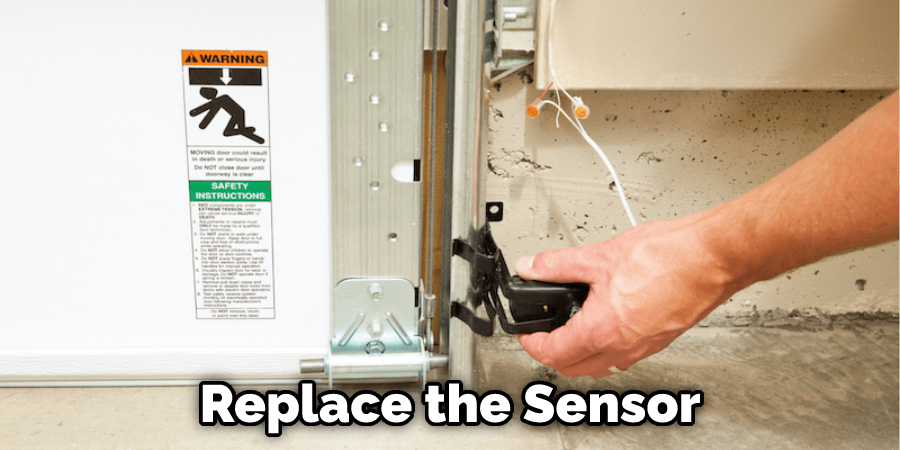
How Much Does It Cost To Fix a Garage Door Opener Sensor?
The cost of fixing a garage door opener sensor will vary depending on the problem. If the problem is something simple, like a dead battery, you can expect to pay around $10. However, if the problem is more serious, like a damaged sensor, you can expect to pay around $100. For a complete list of prices, check out the table below.
Type of Repair Average Cost
- Dead Battery $10
- Replacing Wiring $20
- Replacing the Opener Sensor $100
- Reprogramming the Opener Sensor $30
- Remote Control Not Working $15
- Replacing the Remote Control $35
The price of fixing a garage door opener sensor will vary depending on the location.
How Often Should I Service My Garage Door Opener Sensor?
It is a good idea to service your garage door opener sensor every few months. This will help to ensure that it is working properly and will help to prevent any future problems. If you notice any problems with your garage door opener sensor, you should service it as soon as possible.
How To Prevent Garage Door Opener Sensor Problems
You can do a few things to prevent garage door opener sensor problems. First, make sure that the opener sensor is properly installed. If the sensor is not installed correctly, it may not be able to detect objects in its path. Second, ensure that the opener sensor’s area is free of debris. If there are objects blocking the sensor, it may not be able to detect them. Third, make sure that the opener sensor is clean.
If the sensor is dirty, it may not be able to detect objects properly. Finally, ensure that the opener sensor is not interfered with by other electronic devices. If other devices are causing interference, they may not be able to detect objects properly. If you follow these tips, you should be able to prevent garage door opener sensor problems. However, if you do experience problems, you may need to call a professional for help.
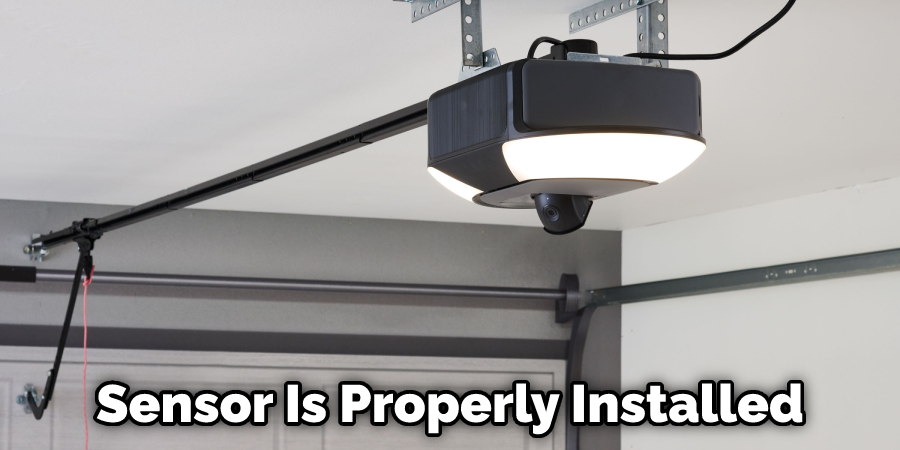
Tips and Warnings on How to Fix Garage Door Opener Sensor
Tips:
- Be sure to read the instruction manual that comes with your garage door opener before attempting any repairs.
- If you’re not comfortable working with tools or electricity, it’s best to hire a professional to do the job for you.
- Always unplug the garage door opener before beginning any repairs.
Warnings:
- Never try to repair a garage door opener yourself if you’re not confident in your ability to do so safely.
- Never touch the garage door opener’s sensors or other electrical components with your bare hands.
- Never attempt to bypass or tamper with the safety sensors on your garage door opener. These are essential for preventing injuries and should never be removed or bypassed.
Frequently Asked Questions
What Are Common Causes of Garage Door Sensor Problems?
Many people experience problems with their garage doors because of faulty sensors. Garage door sensors are small devices that help to open and close your garage door automatically. They work by detecting the presence of someone or something in front of the door, and when this happens, the sensor sends a signal to your receiver unit.
If your sensor is not working properly, it may be due to one of two issues: an obstruction in front of the sensor (like a plank), or wear and tear on the transmitter unit caused by weather conditions or regular use. If you notice any changes in how often your garage Door opens and closes, there may be a problem with your sensor. In either case, you will need to replace it as soon as possible for optimal safety and performance.
Should both Garage Sensors Be Green?
the best way to monitor your garage depends on a variety of factors specific to your home. However, if you are concerned about energy consumption and greenhouse gas emissions, it may make sense to install both green garage sensors and regular sensors.
This way you can get detailed information about what’s happening in your carport or backyard at all times without having to rely on manually entering data into an app. Additionally, by being proactive about monitoring traffic conditions in your driveway or parking lot, you could potentially avoid potential accidents
Will Garage Door Work without Sensors?
every garage door system is unique and requires specific programming in order to operate. That being said, many homeowners have found that their garage door opens and closes with the use of a sensor without the need for programming. If you are experiencing difficulty with your garage door system, it may be best to consult a professional. They can test your system and determine if it requires programming or not.
What Does It Mean When One Garage Door Sensor Is Red and One Is Green?
If one garage door sensor is red and the other is green, it may mean that there’s a problem with the communication between the two sensors. Occasionally, something can interfere with the transmission of signals between these sensors, causing them to incorrectly identify whether or not a door has been opened. In order for this issue to be resolved, you will need to have both sensors serviced by a professional technician.
Conclusion
Garage door opener sensors are one of the most important safety features on your garage door. However, it could be a serious hazard if they’re not working properly. This blog post showed you how to fix garage door opener sensor problems. We hope you found this information helpful and that it helps you get your garage door up and running safely again.
You May Also read: How to Fix Gap on One Side of Garage Door
